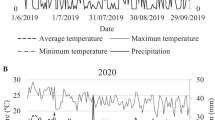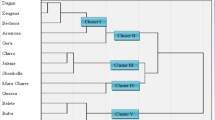Abstract
Differences among cultivars of Solanum tuberosum L. in susceptibility to Sclerotinia sclerotiorum (Lib.) de Bary have been noted through observation and research. Traits hypothesized as having a potential effect upon susceptibility included, flower propensity, time to 50 % flowering, flowering duration, canopy density, oxalic acid sensitivity, and maturity. Field plots were planted using seven cultivars in which these variables were quantified and analyzed. Identification of those factors providing the greatest amount of information towards disease severity were identified using multiple linear regression, and parameter selection using Akaike’s Information Criterion. The factors of maturity (R2 = 0.77), time to 50 % flower (R2 = 0.64), and oxalic acid sensitivity (R2 = 0.57) were identified as providing the greatest predictive indices of white mold severity in potatoes.
Resumen
Las diferencias en la susceptibilidad a Sclerotinia sclerotiorum (Lib.) de Bary entre variedades de Solanum tuberosum L. se ha notado a través de la observación y la investigación. Entre las características de que se tiene la hipótesis de un efecto potencial sobre la susceptibilidad se incluyen la propensión de la flor, el lapso al 50 % de la floración, duración de la floración, densidad del follaje, sensibilidad al ácido oxálico y madurez. Se plantaron lotes en el campo usando siete variedades en las cuales estas variables se cuantificaron y analizaron. Se identificaron estos factores suministrando la mayor cantidad de información hacia la severidad de la enfermedad, mediante el uso de regresión linear múltiple, y por selección de parámetro usando el criterio de información de Akaike. Los factores de madurez (R2 = 0.77), el tiempo al 50 % de floración (R2 = 0.64) y la sensibilidad al ácido oxálico (R2 = 0.57) se identificaron como los que proporcionaron los mayores índices predictivos de la severidad del moho blanco en papa.
Similar content being viewed by others
References
Andrivon, D., J.-M. Lucas, C. Guerin, and B. Jouan. 1998. Colonization of roots, stolons, tubers and stems of various potato (Solanum tuberosum) cultivars by the black-dot fungus Colletotrichum coccodes. Plant Pathology 47: 440–445.
Atallah, Z.K., and D.A. Johnson. 2004. Development of Sclerotinia stem rot in potato fields in south-central Washington. Plant Disease 88: 419–423.
Beketova, M.P., P.E. Drobyazina, and E.E. Khavkin. 2006. The R1 gene for late blight resistance in early and late maturing potato cultivars. Russian Journal of Plant Physiology 53: 384–389.
Belsley, D.A., E. Kuh, and R.E. Welsch. 1980. Regression diagnostics: Identifying influential data and sources of collinearity. New York: Wiley.
Bormann, C.A., A.M. Rickert, R.A.C. Ruiz, J. Paal, J. Lubeck, J. Strahwald, K. Buhr, and C. Gebhardt. 2004. Tagging quantitative trait loci for maturity-corrected late blight resistance in tetraploid potato with PCR-based candidate gene markers. Molecular Plant-Microbe Interactions 17: 1126–1138.
Burnham, K.P., and D.R. Anderson. 2002. Model selection and multimodel inference: A practical information-theoretic approach, 2nd ed. New York: Springer.
Cessna, S.G., V.E. Sears, M.B. Dickman, and P.S. Low. 2000. Oxalic acid, a pathogenicity factor for Sclerotinia sclerotiorum, suppresses the oxidative burst of the host plant. The Plant Cell 12: 2191–2199.
Chase, R.W. 1992. North American potato variety inventory. Orono: Potato Association of America.
Chipps, T.J., B. Gilmore, J.R. Myers, and H.U. Stotz. 2005. Relationship between oxalate, oxalate oxidase activity, oxalate sensitivity, and white mold susceptibility in Phaseolus coccineus. Phytopathology 95: 292–299.
Collins, A., D. Milbourne, L. Ramsay, R. Meyer, C. Chatot-Balandras, P. Oberhagemann, W. De Jong, C. Gebhardt, E. Bonnel, and R. Waugh. 1999. QTL for field resistance to late blight in potato are strongly correlated with maturity and vigor. Molecular Breeding 5: 387–398.
Fry, W.E., and A.E. Apple. 1986. Disease management implications of age-related changes in susceptibility of potato foliage to Phytophthora infestans. American Potato Journal 63: 47–56.
Garrett, K.A., L.V. Madden, G. Hughes, and W.F. Pfender. 2004. New applications of statistical tools in plant pathology. Phytopathology 94: 999–1003.
Guimaraes, R.L., and H.U. Stotz. 2004. Oxalate production by Sclerotinia sclerotiorum deregulates guard cells during infection. Plant Physiology 136: 3703–3711.
Gutierrez, W.A., and H.D. Shew. 2000. Factors that affect development of collar rot on tobacco seedlings grown in greenhouses. Plant Disease 84: 1076–1080.
Hao, J.J., K.V. Subbarao, and J.M. Duniway. 2003. Germination of Sclerotinia minor and S. sclerotiorum sclerotia under various soil moisture and temperature combinations. Phytopathology 93: 443–450.
Harikrishnan, R., and L.E. del Rio. 2006. Influence of temperature, relative humidity, ascospore concentration, and length of drying of colonized dry bean flowers on white mold development. Plant Disease 90: 946–950.
Hegedus, D.D., and S.R. Rimmer. 2005. Sclerotinia sclerotiorum: When “to be or not to be” a pathogen? FEMS Microbiology Letters 251: 177–184.
Herms, D.A., and W.J. Mattson. 1992. The dilemma of plants: To grow or defend. The Quarterly Review of Biology 67: 283–335.
Hurvich, C.M., and C.-L. Tsai. 1989. Regression and time series model selection in small samples. Biometrika 76: 297–307.
Jamaux, I., B. Gelie, and C. Lamarque. 1995. Early stages of infection of rapeseed petals and leaves by Sclerotinia sclerotiorum revealed by scanning electron microscopy. Plant Pathology 44: 22–30.
Johanson, A., and H.D. Thurston. 1990. The effect of cultivar maturity on the resistance of potatoes to early blight caused by Alternaria solani. American Potato Journal 67: 615–623.
Johnson, D.A., and Z.K. Atallah. 2006. Timing fungicide applications for managing Sclerotinia stem rot of potato. Plant Disease 90: 755–758.
Kirk, W.W., K.J. Felcher, D.S. Douches, J. Coombs, J.M. Stein, K.M. Baker, and R. Hammerschmidt. 2001. Effect of host plant resistance and reduced rates and frequencies of fungicide application to control potato late blight. Plant Disease 85: 1113–1118.
Kolkmann, J.M., and J.D. Kelly. 2000. An indirect test using oxalate to determine physiological resistance to white mold in common bean. Crop Science 40: 281–285.
Kolkmann, J.M., and J.D. Kelly. 2002. Agronomic traits affecting resistance to white mold in common bean. Crop Science 42: 693–699.
Kooman, P.L., and R. Rabbinge. 1996. An analysis of the relation between dry matter allocation to the tuber and earliness of a potato crop. Annals of Botany 77: 235–242.
Kora, C., M.R. McDonald, and G.J. Boland. 2003. Sclerotinia rot of carrot: An example of phenological adaptation and bicyclic development by Sclerotinia sclerotiorum. Plant Disease 87: 456–470.
Kora, C., M.R. McDonald, and G.J. Boland. 2005. Lateral clipping of canopy influences the microclimate and development of apothecia of Sclerotinia sclerotiorum in carrots. Plant Disease 89: 549–557.
Krupinsky, J.M., K.L. Bailey, M.P. McMullen, B.D. Gossen, and T.K. Turkington. 2002. Managing plant disease risk in diversified cropping systems. Agronomy Journal 94: 198–209.
Lithourgidis, A.S., K. Tzavella-Klonari, and D.G. Roupakias. 1989. Methods of inoculation of faba bean plants with Sclerotinia sclerotiorum. Journal of Phytopathology 127: 123–128.
Putnam, M.L. 2004. First report of stem rot of rosemary caused by Sclerotinia sclerotiorum in the United States. Plant Pathology 53: 252.
Rodriguez-Falcon, M., J. Bou, and S. Prat. 2006. Seasonal control of tuberization in potato: Conserved elements with the flowering response. Annual Review of Plant Biology 57: 151–180.
Sands, P.J., C. Hackett, and H.A. Nix. 1979. A model of the development and bulking of potatoes (Solanum tuberosum L.). Field Crops Research 2: 309–331.
Sexton, P., A. Plant, S.B. Johnson, and J. Jemison. 2007. Effect of a mustard green manure on potato yield and disease incidence in a rainfed environment. Crop Management. doi:10.1094/CM-2007-0122-02-RS. Online.
Simko, I., K.G. Haynes, and R.W. Jones. 2004. Mining data from potato pedigrees: Tracking the origin of susceptibility and resistance to Verticillium dahliae in North American cultivars through molecular marker analysis. Theoretical and Applied Genetics 108: 225–230.
Stewart, H.E., J.E. Bradshaw, R.L. Wastie, G.R. Mackay, O. Erlich, L. Livescu, and A. Nachmias. 1994. Assessing progenies of potato for resistance to early blight. Potato Research 37: 257–269.
Visker, M.H.P.W., H.M.G. van Raaij, L.C.P. Keizer, P.C. Struik, and L.T. Colon. 2004. Correlation between late blight resistance and foliage maturity type in potato. Euphytica 137: 311–323.
Vuong, T.D., D.D. Hoffman, B.W. Diers, J.F. Miller, J.R. Steadman, and G.L. Hartman. 2004. Evaluation of soybean, dry bean, and sunflower for resistance to Sclerotinia sclerotiorum. Crop Science 44: 777–783.
Wegulo, S.N., X.B. Yang, and C.A. Martinson. 1998. Soybean cultivar responses to Sclerotinia sclerotiorum in field and controlled environment studies. Plant Disease 82: 1264–1270.
Wharton, P., and W. Kirk. 2007. Michigan potato diseases: white mold. Michigan State University, Extension bulletin: E-2989.
Zhao, Y., and M.L. Wang. 2004. Inheritance and agronomic performance of an apetalous flower mutant in Brassica napus L. Euphytica 137: 381–386.
Acknowledgments
We appreciate the help and support of Erica and Albert Fitzpatrick, Bruce and Brandon Roope, Steve Gray, Gregory Alley-Violette, Elbridge Giggie, and James Dwyer. This work was supported in part by a grant from the Maine Potato Board Research Committee.
Author information
Authors and Affiliations
Corresponding author
Rights and permissions
About this article
Cite this article
Plant, A.B., Lambert, D.H. Host Traits Influencing Severity of White Mold of Potatoes in a Rainfed Environment. Am. J. Potato Res. 90, 386–394 (2013). https://doi.org/10.1007/s12230-013-9327-y
Published:
Issue Date:
DOI: https://doi.org/10.1007/s12230-013-9327-y




